 | At the outbreak of World War Two the Constructions Navales shipyard at La Coitat was in the process of laying down the keel for a new vessel. The war slowed down the building of this vessel, it was not until 1944 that it was launched, named Marechal Petain. The unfinished hull was towed to Port Bouc to await the end of the war. However in August 1944 the retreating Germans sank the ship in shallow waters. The ship's owners raised the vessel during 1946 and moved it to Toulon, despite its sinking the damage sustained was minimal. |
The ship returned to its original builders for repair and fitting out, by 1949 it was ready to be placed into service. Its name had been changed, the former name was now associated with the collaborationist and very unpopular Vichy regime of the Nazi occupation, the more patriotic La Marseillaise was chosen.
Passenger accommodation and facilities ranged from A Deck to F Deck and included:
A Deck:
The kitchen servicing the First Class Dining Room. A portion of the Dining Room ceiling was cut away into B Deck.
B Deck:
First Class Cabins Nos 147 - 165 odd numbers (port side)
First Class Cabins Nos 144 - 180 even numbers (starboard side)
Tourist Class Cabins Nos 167 - 185 odd numbers (port side)
Tourist Class Cabins Nos 182 - 208 even numbers (starboard side)
All cabins had washbasins, but baths, showers and toilets were located in the center of the deck.
C Deck:
First Class Cabins Nos 101 - 145 odd numbers (port side)
First Class Cabins Nos 102 - 142 even numbers (starboard side)
All cabins on this deck contained either a shower and/or a bathtub, not all contained a toilet, rooms containing six toilets and several bathtubs were located in the center of the deck.
This deck contained two deluxe suites, the Provence (port side) & the Cote d'Azur (starboard side)
C Deck also contained the Barber Shop & Beauty Parlor, the Surgeon and the Pursers.
D Deck:
First Class Cabins Nos 1 - 99 odd numbers (port side)
First Class cabins Nos 2 - 100 even numbers (starboard side)
D Deck was the only deck with symmetrical passenger accommodation for the port & starboard sides.
Most cabins had a shower, some were equipped with a toilet. Other toilets and bathtubs were located at either end of the deck or in small rooms alongside the passageways providing access to the cabins.
This deck contained the Children's playroom, the First Class Swimming Pool - a cut out in E & F Decks provided natural light for the pool.
E Deck:
There were no passenger cabins on this deck, but it featured the First Class Verandah Cafe (overlooking the bow), First Class Smoking Room, First Class Drawing Room, the Writing Room, the Bridge Room and towards the stern the Tourist Class Bar & Smokeroom.
F Deck:
Whilst the F Deck carried many of the ship's offices, the passenger Gymnasium was located at the rear of the deck.
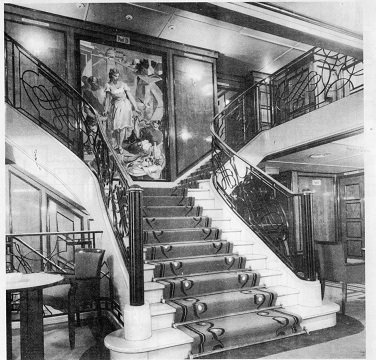 | The First Class Staircase connecting C Deck with D Deck. | 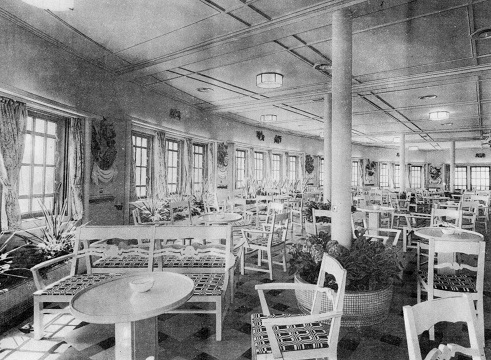 | The First Class Verandah Cafe on E Deck overlooked the bow and spanned the full width of E Deck. The First Class Smoking Room was off-picture to the right. | 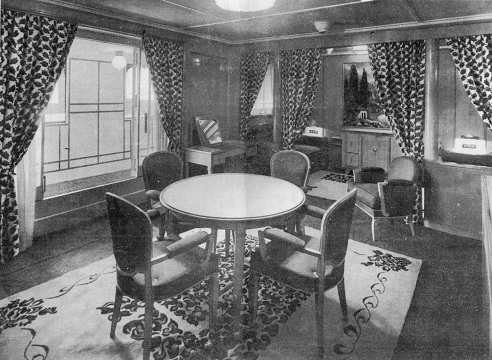 | The ship contained 75 Tourist Class cabins and 346 First Class cabins. C Deck contained the two most well appointed cabins identified as 'Provence' (cabin 109) and 'Cote d'Azur' (cabin 110). The image shows the 'Provence' cabin, which included a balcony. |
1943 January 29th:
Article from Daily Commercial News & Shipping List (Sydney) ??
French Motorships, Marechal Petain and others.
Rather more information about French shipbuilding is now being received than for some time (states an English shipping paper). French naval architecture in the years preceding the war was an art of which France could be proud. There was a keen appreciation of the possibilities of new forms of propulsion, and it must always be remembered that French marine engineers did more perhaps than any other country to develop electric propulsion for special types of ships. On the small craft side, France pioneered the diesel-electric bucket dredger, the diesel-electric hopper, the diesel-electric buoy and lightship tender, and had some of the largest diesel-electric suction dredgers in the world.
The liner Normandie will ever stand as a monument to French marine engineering and naval architectural imagination. The Kairouan, built for the North African service, and a vessel in which much of the experience gained as a result of building and operating the Normandie has been used, has recently been launched and presumably is fitting out. Now comes further detailed news of the big triple screw motor liner Marechal Petain. She is the sixth big motorship with this number of screws for propulsion in the world, and the eighth if we include two British-built ships constructed on the Clyde and engined by Harland & Wolff Ltd. for service on the River Plate.
The Boissevain. The two ships last mentioned were built in 1929. No further triple-screw motorship joined the world's merchant fleets until the Koninklijke Paketvaart Maats took delivery of the Boissevain and two sister ships in 1938. These 14,134 tons gross liners were designed for the service connecting Hong Kong with South Africa. Their engines had a total of 10,800 h.p., each machine running at different revolutions for the same output.
Just before the outbreak of war came the 19,850 tons gross Oranje for the Java service of the N.V. Hijoomvaart Maats, Nederland; this ship had 37,500 h.p. on her three screws. The ill-fated Stockholm, originally intended for the Swedish American Line, after being burned out, was reconstructed and sold to the Italians. This 28,000 tons gross triple screw ship had engines developing 22,000 s.h.p. It is interesting to remark that in each case mentioned, with the exception of the river ship which pioneered triple-screw propulsion, the same type of machinery has been employed, the Sulzer single-acting two-cycle engine. In each ship the desire of the designer has been clear, namely, the provision of a large power output, in proportion to the size of the ship, with a low headroom, thus permitting the passenger decks to be built as low down in the ship and with as little interruption as possible from any up takes. Some naval architects and engineers think that this desirable end is better accomplished by gearing engines in pairs to the screw, but the triple-screw technique has now advanced so far that it is likely to have an effect upon past-war ship design.
The owners of the Marechal Petain are the Cie. des Messageries Maritimes, whose immediate pre-war fleet comprised 22 steamers and nine motorships on the Services Contraetuels side, and 11 other steamers. The Marechal Petain has been built for her owners Far Eastern service. She has a load displacement of 18,900 tons, a gross tonnage of 15,500 tons and a total deadweight capacity of 5600 tons. The maximum engine power is stated to be 31,000 b.h.p., which is within 6,500 h.p. of the maximum output of the Oranje, hitherto the world's most powerful motorship. The normal output, however, is 25,000 b.h.p., the corresponding speeds being 22 and 23 knots. In the normal course of events the Marechal Petain, which was launched recently, would have run to the eastern service with motorships of the 'Felix Roussel' class, but will be much larger and faster than those vessels. The Messageries Maritimes was one of the few French companies to show any interest in the oil engine, and in the past had used both licence-built Burmeister & Wain four-cycle and Sulzer two-cycle diesels. The total output of the Felix Roussel, on twin screws, is only 11,000 b.h.p., her speed being 17 knots, so it will be seen that a great step-up in speed has been contemplated. Doubtless when this liner was designed the owners had in mind that nearly all the companies engaged in trading to the Far East were building bigger and faster ships, and doubtless the triple-screw motor liner Oranje must have been one of the main contributory causes to the Marechal Petain being laid down.
The liner was built at La Ciotat. The three main engines are of licence-built Sulzer design and are of the standard type employed in previous ships, in particular in three fast cargo liners designed for Far Eastern services. Each motor has 11 cylinders, of 720 mm. diameter and 1250 mm. stroke, and it is expected that the 'tons-per-24 hours' at the lower speed mentioned above will be 110 tons. It is also stated that the fuel capacity is 1710 tons.
If she is interesting on the main propelling side, the Marechal Petain is outstanding on the auxiliary side, for alternating current is to be used for all purposes throughout the ship. If this statement is to be interpreted literally, then the new French liner will be the first motorship, apart from those in which electricity is used for propulsion itself, in which such an arrangement has been made. Details of the electrical equipment are meagre, but it would appear that four Sulzer diesels drive 950 K.V.A., 220 v., 50-period, 3-phase alternators, and that pump motors, ventilator motors, deck gear, refrigerating and cooking plant are run at this voltage, suitable transformers being fitted for the lighting current.
The Distillation Plant. It will be recalled that one of the interesting features of the design of the Oranje was the distillation plant. A similar plant is to be installed in the new French ship, and Sulzer-Lamont exhaust gas boilers are to be used in conjunction with it. It is stated that 150 tons of fresh water will be produced per hour, of which 10 tons are to be used in the cooling circuits for main and auxiliary engines and 140 tons for hotel services. By this means it has been possible to reduce to only 490 tons the amount of fresh water carried in the tanks.
In appearance this important motorship is something like the Union-Castle motor liners as regards the funnel and to some extent the stern, and the Normandie as regards the bow, the same curved raking stem being designed. The superstructure has a curved end, rather raking forward, somewhat reminiscent of that used in the Danish mail ship Kronprins Olav. This new French motor liner, on the other hand, has not adopted the device used, in the Oranje of having only one mast, since she has two masts of normal appearance, though the mainmast appears to be rather lower than the foremast.
Two classes of passengers only are to be carried, in contra distinction to some French ships, which sometimes carry five classes and sub-classes. There will be only 374 passengers in first and tourist, but there are interchangeable cabins, so that first class and tourist may be increased or decreased as desired. Some 260 emigrants and deck passengers can also be carried. The Marechal Petain, then, is France's latest contribution to the art of motorships and engines. Few distinguished motorships have entered on their career at a more difficult period in shipping history. That her completion may be considerably delayed seems very likely; that she is a milestone on the long road of marine diesel engine development is inescapable, and further details about her will be of great interest to the shipping industry.
The ship had been fitted out for working the route to the French colonies in South East Asia, in this case Saigon, making her maiden voyage on August 19th 1949. Ports of call included Port Said, Djibouti, Colombo, Singapore, Saigon, Hong Kong & Manila. The ship remained on this run until early in 1954. The sun had set on the French colonies in the Far East, the need for ships like La Marseillaise had greatly diminished. The ship was reallocated to Mediterranean duties, but proved unsuitable for this, her French registry also provoked resentment due to French military action in Algeria. The ship was commandeered by the French government in the Algerian crisis and later in 1956 for the Suez crisis, when it made two sailings as a hospital ship, in addition to being a troop carrier. When the ship was returned to Messageries Maritime in February 1957 it was obvious that it no longer had a future under its existing role.
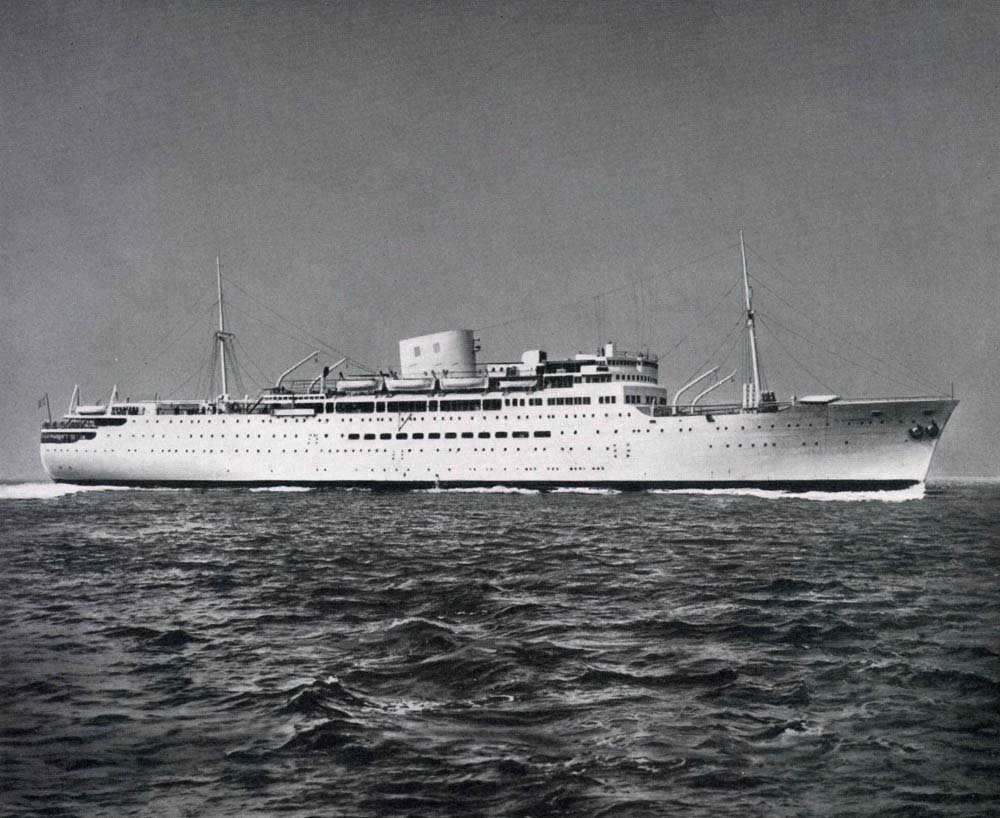
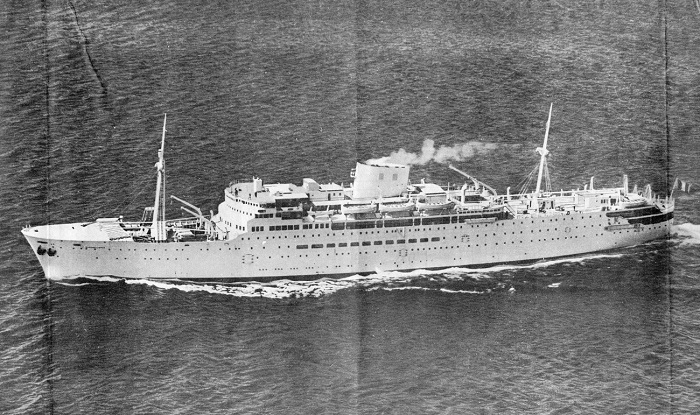
As a result the ship was almost immediately sold to the Panama based Arosa Line and renamed Arosa Sky, see view below. Her passenger accomodation was reconfiguered to cater for the predominantly tourist class passengers that the ship was aiming to cater to. The first voyage under the new owners was on May 10th 1957 from Bremerhaven to New York. Within a year the Arosa Line was facing bankruptcy, the ship being sold on to the Costa Lines
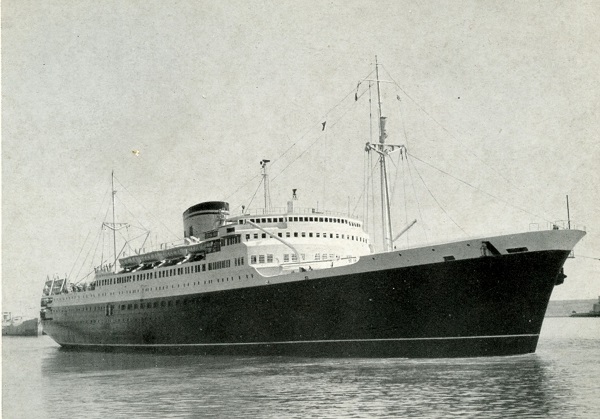
After a refit the ship entered service during 1959, now named the Bianca C, see view below, working the Naples - Genoa - La Guaira (Venezuela) circuit.
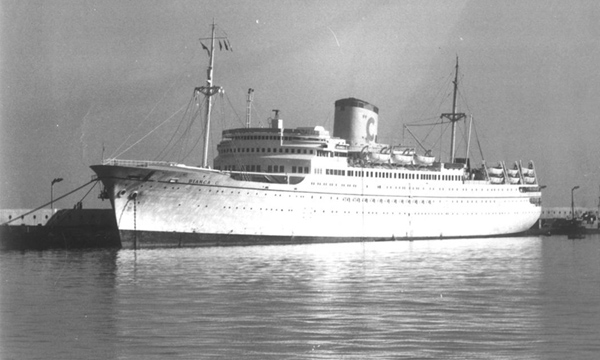
The ship's last voyage commenced on October 12th 1961, on the regular route from Naples to La Guaira. Ten days into the trip whilst anchored in the harbour at St George, Grenada an explosion in one of the engine's air manifolds ruptured a nearby fuel tank. This explosion started a fire which could not be contained and spread throughout the ship. The quiet Sunday morning was soon disturbed by the Bianca C's whistles sounding the emergency alarm. The town's residents responded magnificently, literally using whatever was afloat in the harbour to assist the evacuation of the ship's passengers and crew. Such were their efforts that of the 673 people on the ship only three died in the tragedy, one crewman was killed in the initial explosion, two other crew died later of their injuries.
The fire burned out of control for several days - the crew were never able to use the onboard firefighting equipment and the port of St George had nothing suitable for such a large fire. A nearby naval vessel, the British frigate HMS Londonderry out of Puerto Rico was summonsed to provide assistance, the port authorities were concerned the ship might sink and block the harbour channel, however the captain would not allow the Bianca C to be moved until properly inspected. The decision was made to tow the ship from the harbour and beach her in nearby shallow water. The tow was only partially successful, the ship was able to clear the harbour, but controlling the ship in open water with a jammed rudder was too much for the small frigate. The tow line eventually parted, the ship started to take on water and sank on an even keel in waters 150 feet deep about one mile from Port Saline. The Bianca C came to rest upright on a sandy part of the ocean floor. The stern separated from the rest of the ship coming to rest on its starboard side.
Because of the proximity of the wreck to St George it became a major attraction for divers. The wreck has been looted of its more valuable scrap metals, brass etc, and most notably its bronze propellors. The damage caused by the fire and its four decades on the ocean floor have considerably weakened the structure to the extent that it is now starting to collapse in on itself.

Length: 593 feet
Breadth: 75.5 feet
Gross Weight: 17,321 tons; 18,427 tons as Bianca C
Engines: 3 x 8,330 bhp @ 131rpm or 10,330 bhp @ 141rpm
Screws: 3
Maximum speed: 22 knots
Passengers: 344 1st, 74 2nd, 318 3rd as La Marseillaise; 202 1st & 1,030 tourist as Arosa Sky
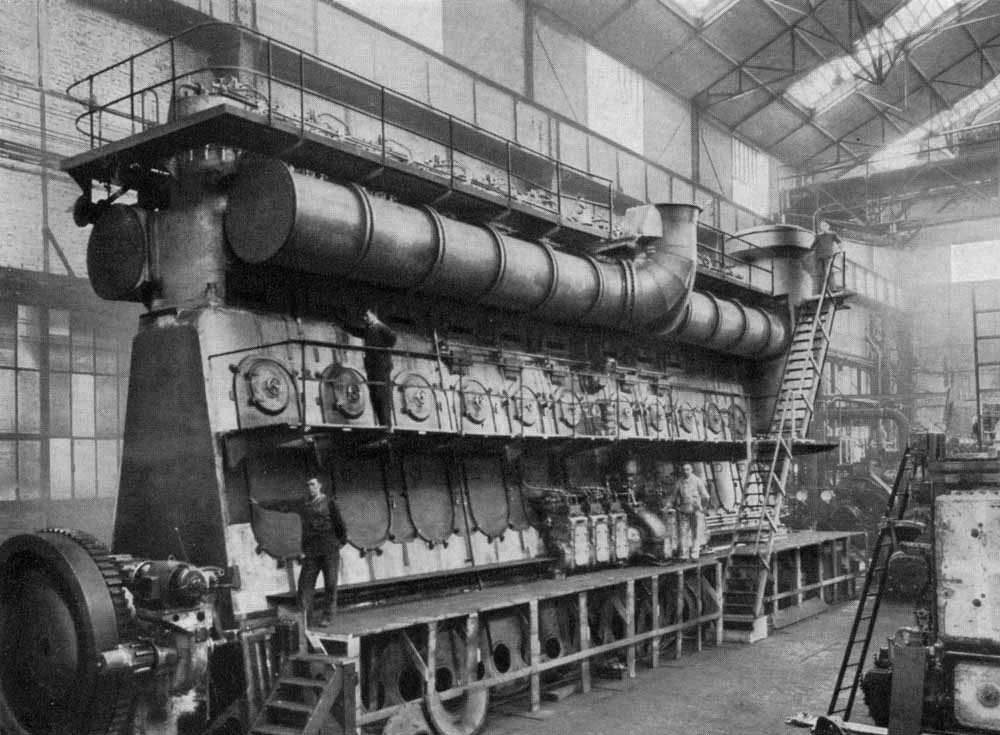
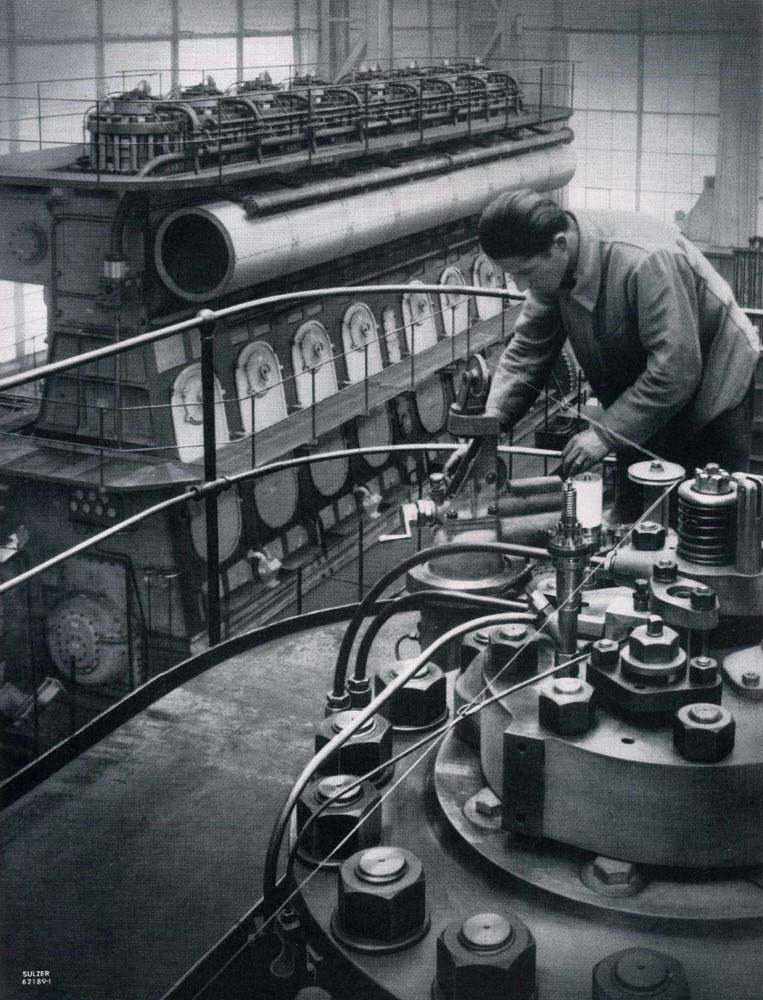

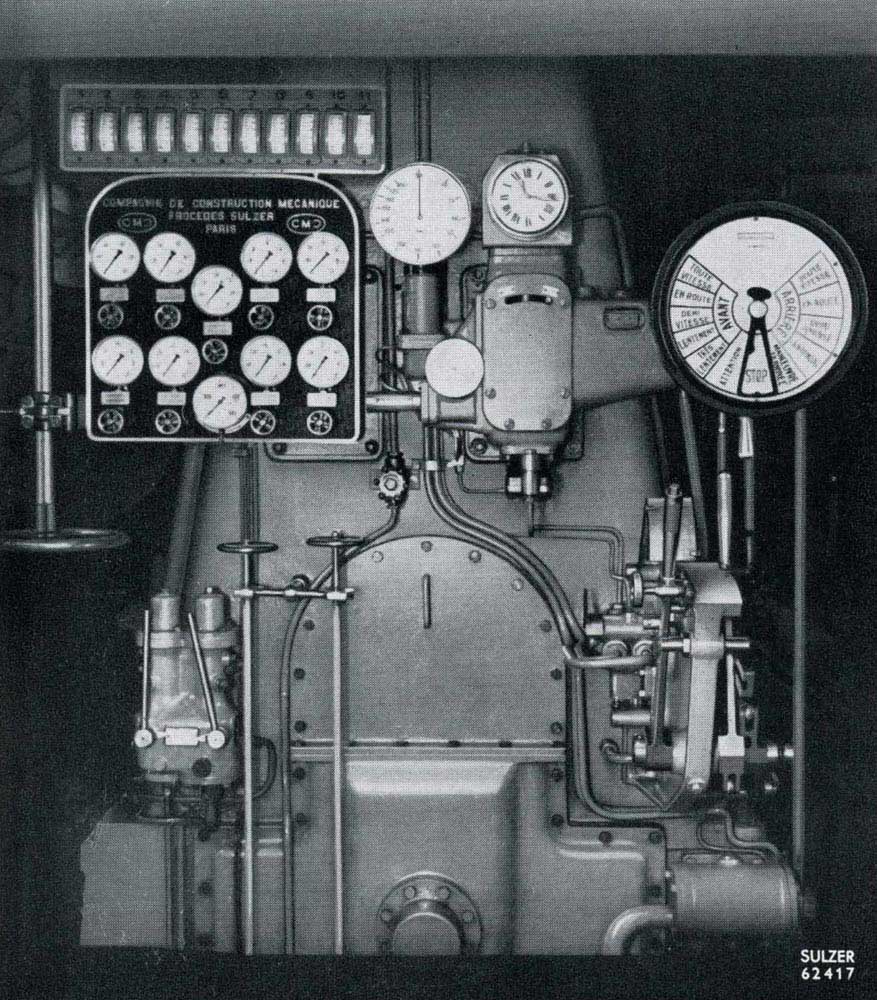
One or two people who have stopped by this website have, besides their interest in railways, professed an interest in scuba diving. The following notes and views come from Lindsay Knight who has dived on the wreck of the Bianca C and reports that it is one of the world's top ten wrecks to dive on.
The ship now sits in about 170 feet of warm Caribbean waters - clearly evidenced by the colourful growth across the ship's structure. As mentioned the fire weakened the ship's structure causing the stern to twist through ninety degrees, ending up on its side whilst the rest of the ship sits upright on the seafloor, still attached to the stern by a mass of twisted wreckage. Forward of the bridge much is still intact. At some point the funnel fell to the starboard side and now lies flattened on top of the wreckage, the giant 'C' can still be made out.
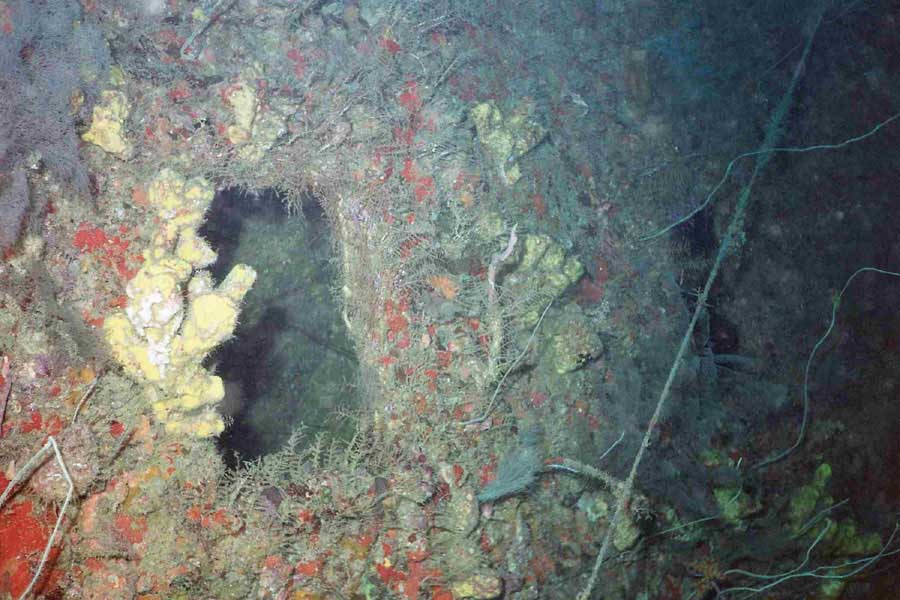
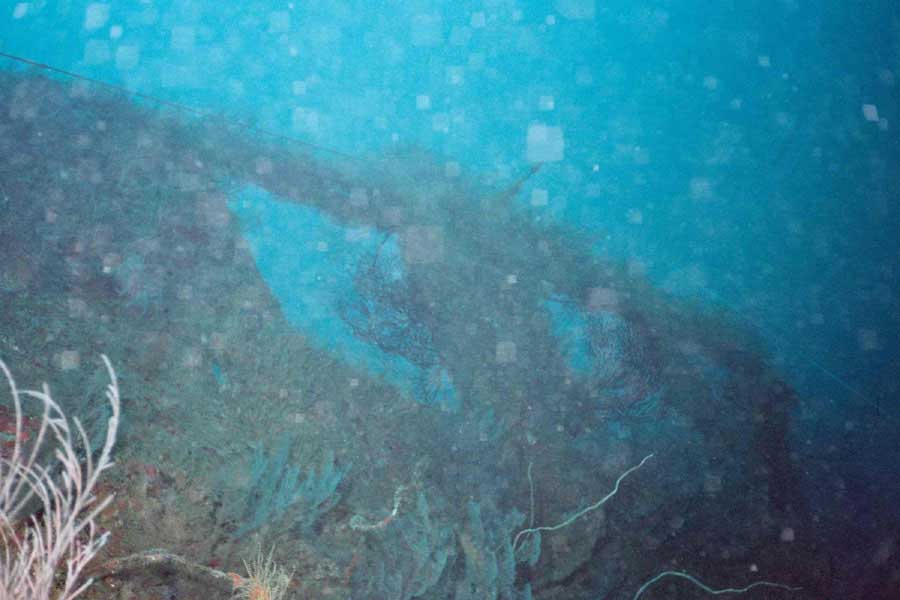
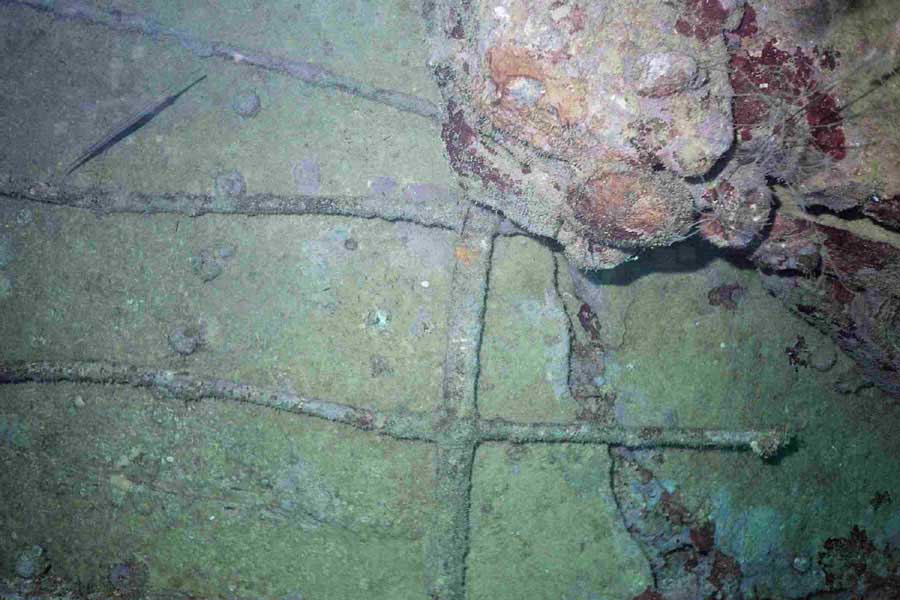
The three views above come from the camera of Lindsay Knight and show a passenger cabin, looking up to the promenade deck and a ship's railing.
Sources:
Sulzer Technical Journal No.1 from 1950.
National Library of Australia : Trove website of archived Australian Newspapers (trove.nla.gov.au)
Page added February 22nd 2004.
Last updated February 11th 2016.
Return to Ship menu
Return to site menu